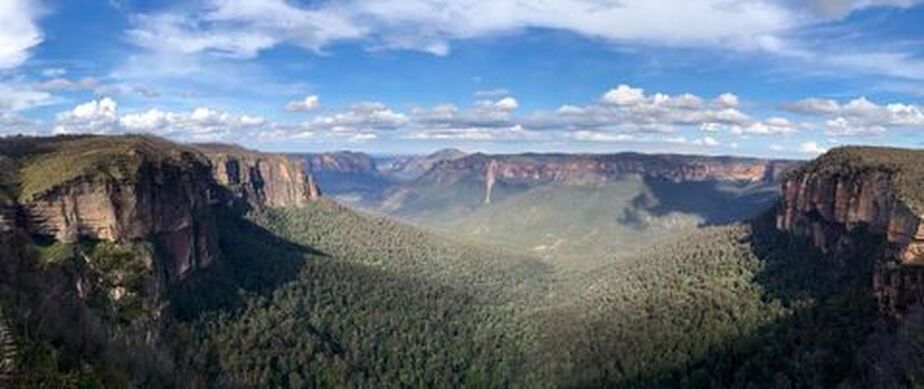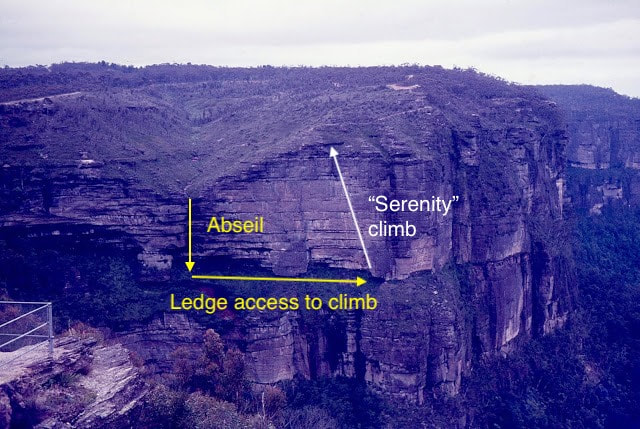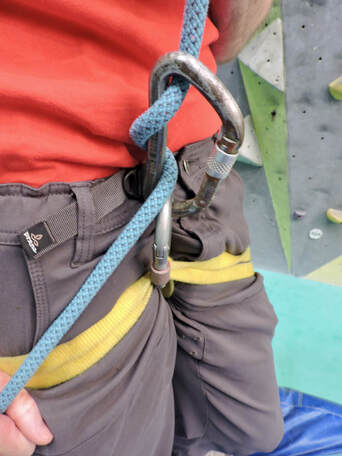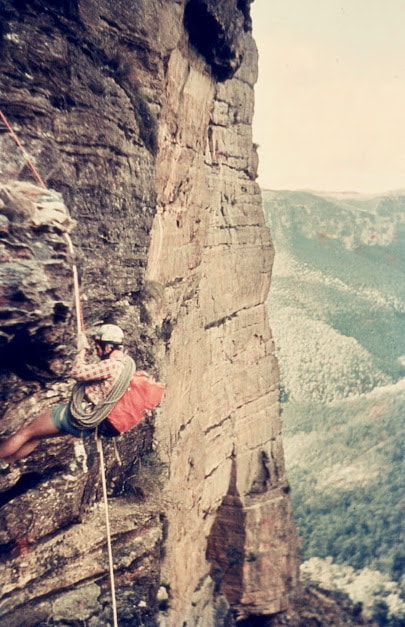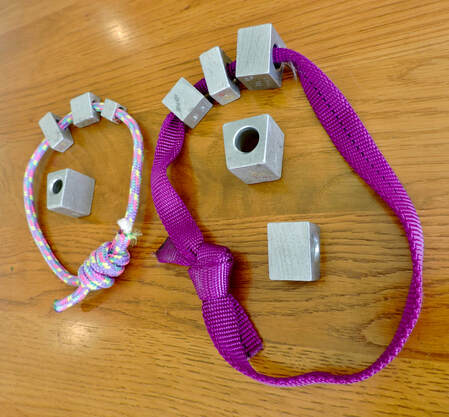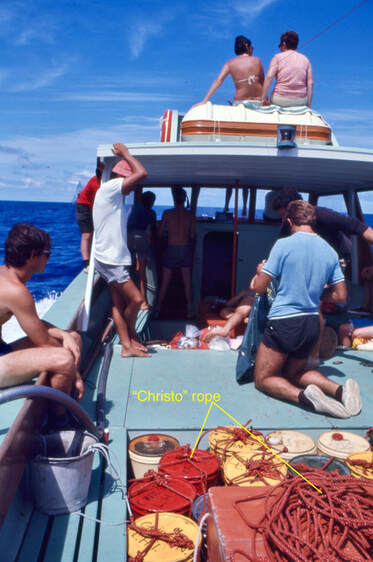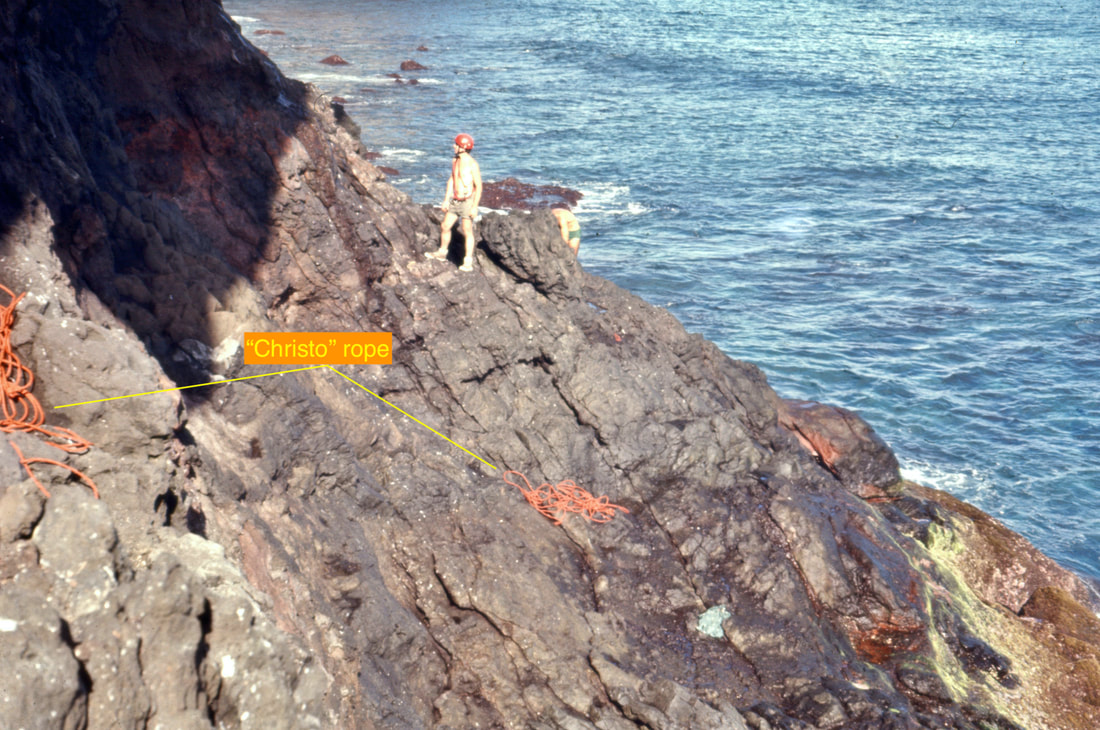Govetts Leap, one of the most scenic lookouts in the Blue Mountains, has a disarmingly apt name for the site of an abseiling fiasco. Straight ahead, beyond Pulpit Rock, the confluence of Govetts Leap Creek and the Grose River can be seen, surrounded by mighty canyons and the rocky bulwarks of Mount Banks and Hay. To the right, the silvery stream of Bridal Veil Falls tumbles over a mighty precipice into the valley below, while on the left, Horseshoe Fall is hidden by its constricted valley. Between the two, left of Pulpit Rock, is an impressive wall with a rounded top formed by two deeply eroded hanging valleys on either side. The wall is split by a soaring crack reminiscent of Mount Piddington’s, The Eternity but almost six times as high and sloping the other way. In May 1970, Howard Bevan and I climbed this crack. We named it Serenity, mocking the trials and tribulations that we encountered, the first of which was access.
|
To get to the base of the crack required descending about 150 metres (nearly 500 feet) from the left-hanging valley through a small waterfall to a half-way ledge. The abseil was through thin-air apart from the initial five metres. The government department where I worked kindly donated a coil of 2-inch circumference manilla rope for transport to our destination. We also set up a toprope using a length of the "Christo" rope we received from the man himself after his Little Bay “Wrapped Coast’ Art Exhibit was wrapped up (See Christo's Little Bay Rhapsody to learn more about the odd and nearly life-threatening origins of this rope - perhaps this rope is cursed?).
We tied the "Christo" rope into our swami belts (which is basically a length of seat-belt webbing fastened around the waist) to give an illusion of security. The redoubtable Bruce Rowe, affectionately known as "Rowetund" on the Balls Pyramid trip earlier in 1970, was belaying us around his waist, as was the custom at the time. As wide as he was high, Bruce was a formidable and reliable anchorman. Howard lost the toss of the double-headed coin and went down first - as far as I could tell - without incident. All too soon it was my turn. |
|
Now this was 1970 and there weren’t any harnesses or sophisticated brake bars for rappelling: the harnesses we used required stepping into a sling and pulling the section in front of your thighs through the crotch and securing the front and back with a large "Stubai" D-shaped screw-gate carabiner. The braking was provided by a twisted loop or two around the carabiner’s main stem. We could have also used crossed carabiners or an angle piton clipped as a brake bar across a locking carabiner - but we didn't. While this sounds very primitive, they were probably the best systems around at the time, as it was a few years before the figure-eight descender made its appearance.
All went well for the first 120-metres until I began coming across the twists and kinks in the rope created by Howard’s descent. The further I went the worse it got. This difficulty was compounded by the size of the rope and the fact that it was now saturated with water from the waterfall and was quite cold. In retrospect, we were also very eager for the rope to reach the landing ledge without requiring knots - which are a pain and often dangerous to get around - so there was quite a bit of loose slack on the ledge which stopped the rope from rotating freely and releasing the kinks as we descended. Very soon I needed all my strength and both hands to push the rope through my abseil device. As I slowly descended, I was getting wetter and wetter and pushing the rope through the carabiner became even harder — before too long I could hang hands free. Eventually, I couldn’t hold myself upright and fell upside down. This was complicated further by my much-loved Whillans pack which, although a striking orange colour, was bigger at the top than the bottom and loaded with climbing gear - Peck Crackers, Spuds, MOACS, Ewbank’s nuts, as well as sundry pitonry. Then there was food, water, spare clothes, and bivvy gear. It was bloody heavy! As a result, my sit sling began to ride up my thighs (we’re not talking "wedgie") and any attempt to push the rope through the carabiner just made this worse. Finally, the system locked up altogether and I was left dangling upside down on the end of a 120-metre metronome. As I hung there, helpless like a beached whale with blood rushing to my head, I felt like it was time to strike up the band and a play a funeral dirge while I gently glided towards the wall, then out over the ledge where there was an additional 150-metre drop. As I swayed back and forth across the abyss my mind wandered, as it does when you are just "hanging out." Somewhat crazily, I remembered a Tarzan movie I had seen at a Saturday matinee when I was a kid. Tarzan had been hung up on a rope by his heels and he was swinging to and fro across a boiling cauldron. I would have actually preferred this scenario as it was closer to the deck, warmer, and did not have the split-level view. |
A Historical Side-Note About Ropes and Abseiling" |
Howard had already changed into dry clothes and was reluctant to move back into the wet zone. Eventually, though, he realised that I was the proverbial carcass hanging in the butcher’s shop and I wasn’t going anywhere without some external help. After what seemed an eternity, Howard eventually moved back into the line of fire and started untwisting the rope. With that I finally started to make downward progress, albeit still head down. My head finally touched terra firma, which was a wet, slick, and slippery, rock platform with a ski-jump-shaped drop leading towards the lip of the second 150-metre plummet. I feared that as I exited my rappel system, I might slip and catapult into the void I had been eyeballing for so long. Fortunately, further aerobatics/aquanautics did not occur as we made our way out of the creek and across to the start of the climb.
This abseil was the eventful start to almost two days of free and aid climbing to reach the top.
This abseil was the eventful start to almost two days of free and aid climbing to reach the top.
Howard’s Abseil |
Somehow, I kept fighting the urge to give up and found that if I wrapped the trailing rope around my leg, I could bend my knee and win about 2-inches (50mm) of slack to force the rope through the carabiner. I have no idea how long it took, but it must have been 15 minutes or more before I finally touched down on the slick rock at the bottom of the abseil. I was so exhausted that I could not open the carabiner to get off the rope. Even using both hands and both thumbs to hold the gate open the rope remained inviolate to my efforts. Then with the use of a nearby stick I pried the gate open which allowed me to finally extricate myself. It must have taken me nearly 5 minutes to get off that damn abseil.
I tried to shout up to Keith that I was off the line, and that he should only use one twist (Not two as we had agreed) around the stem of the big D crabs we were using to descend. The overhang and the noise of the waterfall drowned out my shouts, so I gave up. I can’t imagine what Keith must have been thinking as he waited patiently for me to get off the rope so he could start down. Why was I taking so long? I tried to untangle some of the abseil rope but just did not have the energy or strength to make much headway. I was shaking so much I wondered if I was hypothermic - almost unheard of in an Australian autumn so I scrambled up under the overhang, put on my dry cloths and waited for Keith to appear.
When he did, he was upside down, pulling himself down the abseil headfirst. Compared to my snail pace he was really flying down the rope. I distinctly remember how mad I was that I did not think of descending this way. He was asking me to help him, but he was doing so well, and I was wearing my only dry clothes that it took some convincing to move out from my shelter into the firing line. However, seeing that he was stalled and near-drowning, spurred me into action. I managed to untangle a small amount of rope which enabled him to continue, then struggled to lift him into a vertical upright position when he arrived.
It is now over fifty years ago, and I have never told this story. Keith never knew how close I was to moving on to the next realm, and I never knew how deeply he was affected by his experience on the way to Serenity”.
Howard Bevan – Vancouver Island, Canada 2021
The Climb
|
In the early 1970’s the climbing gear available was still – may it be said – primitive. There was nothing that really suited wide or thin cracks and most nut placements were unstable given the solidity and small end sections of the aluminium extrusions used. Passive was the go-to protection and cams still had a few years before they made their appearance. It was a tough haul up that crack and from memory we graded it 18 (5.10a) and M4 (an Aussie mixed-climbing grading system where M4 refers to slabby to vertical climbing that requires some technical dry tooling).
The second pitch was the crux as it was a strange, overhanging wide crack that was difficult to protect owing to its size and bizarre structure. For the belay on the next pitch we placed a nut in a horizontal slot, which was jammed so tightly it could not be removed. We left it and moved on. The pitches above now followed a fine crack into which Chouinard "stoppers" would have slotted in nicely but again it was a year or two before they were available in Australia. The short last pitch to escape the vertical was an awkward steep wall and it was here that we placed our only piton. |
In the early 1980’s Greg Mortimer and I returned to free the climb. It was a nostalgic moment when I climbed back onto the third belay ledge and there was the abandoned nut now hanging loosely in the slot. After Greg lead the next pitch and it was my turn to climb, I ruminated on whether I should dig out the "Spud" or just leave it. In the end I left it. My reasoning was to leave it as a monument to the passage of time and the evolution of gear. I often wonder if it is still there.
We successfully freed the climb in a very short day and rated it 22 (5.11a).
No doubt the incremental development of the gear available made a large contribution to the ease of this second ascent. We also found an alternative descent to access the climb that was much shorter and contained less free fall but entailed negotiating a knot - never easy when abseiling. I’m pleased to report that this descent went without incident and avoided waterfalls as well as the previous pitfalls.
And what of that reddish-brown Christo rope that created so much ambivalence as to its worth and usefulness? Somehow it disappeared into the mists of time, but I do remember seeing it being used to moor the boats at Lord Howe Island many years after our Balls Pyramid expedition in 1970.
We successfully freed the climb in a very short day and rated it 22 (5.11a).
No doubt the incremental development of the gear available made a large contribution to the ease of this second ascent. We also found an alternative descent to access the climb that was much shorter and contained less free fall but entailed negotiating a knot - never easy when abseiling. I’m pleased to report that this descent went without incident and avoided waterfalls as well as the previous pitfalls.
And what of that reddish-brown Christo rope that created so much ambivalence as to its worth and usefulness? Somehow it disappeared into the mists of time, but I do remember seeing it being used to moor the boats at Lord Howe Island many years after our Balls Pyramid expedition in 1970.
Check out Keith Bell's stories that include details of the amazing Ball's Pyramid trips:
- Animal Acts Part 1: Things With Wings (by Keith Bell) - Keith Bell has a way with words and some rich climbing tales. In part one of a two-part series Keith shares four laugh-out-loud tales of climbing encounters with "Things With Wings."
- Animal Acts 2: Things That Slither, Crawl, and Walk (By Keith Bell) - Keith Bell wraps up his entertaining two-part series on critters he has encountered while climbing. From snakes, to things with fur and exoskeletons, these stories will make you laugh, cringe, or be fascinated - or all of the above.

